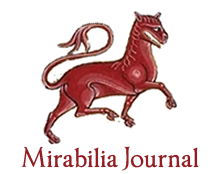Miguel de Cervantes (1547-1616) and the Aesthetics of his Age
Antonia Javiera CABRERA MUÑOZ
Original title: Miguel de Cervantes (1547-1616) y la Estética de su Tiempo
Published in The Medieval Aesthetics
Keywords: Aesthetics, Don Quijote de la Mancha, Miguel de Cervantes, Renaissance.
Contrary to other writers in the Spanish Golden Age, such as Luis de Góngora, Francisco de Quevedo and Calderón de la Barca, Miguel de Cervantes (1547-1616) is considered as being an autodidact by experts. From the publication of La Galatea (1585) on, Cervantes begins to devote himself fully to Literature. His journey through several genres and subgenres makes him both pertaining and alien to his own time, since he starts to deal in his works with a variety of aesthetic topics (authorship, reading, literary creation, etc.) that put in question particularly the previous age, the Renaissacence. The aim of this study is to survey some of those aesthetic topics in Don Quixote (1605 and 1615), in order to establish Cervantes’s worldview as the author of the most ingenious work in Spanish Literature.
Misogyny and theologizing rhetoric of feminine appearance in the Middle Ages: the ascetic testimony of De cultu feminarum by Tertullian
Pedro Carlos Louzada FONSECA
Original title: Misoginia e retórica teologizadora da aparência feminina na Idade Média: o depoimento ascético do De cultu feminarum, de Tertuliano
Published in Mulier aut Femina. Idealism or reality of women in the Middle Ages
Keywords: Female appearance, Misogyny, Patristic, Tertullian.
The concern of the early centuries of Christianity about the appearance of women is a recurring theme in the so-called patristic literature, whose doctrine was based on a vision of theological and patriarchal jurisdiction committed to certain postures and attitudes tendentiously misogynistic that had seen the woman as prone ab origine to disguise and adulteration of her image created by God. In this primeval Christian perception of the female, Tertullian (c. 160-c. 225) stands out as an author of a moralist discourse strongly religious which submits female clothing and ornaments to precepts and prescriptions theologically constituted. This article proposes to discuss the main aspects of the rhetoric of this theological cosmetology which characterizes itself as ascetically misogynist in Tertullian.
Moro-Moro Criticism and Aesthetics: al-Andalus and the Moors and Christians Philippine Theatre
Isaac DONOSO
Original title: Crítica i Estètica del Moro-moro: Al-àndalus i el teatre filipí. De moros i cristians
Published in
Keywords: Al-Andalus, Alcoy, Hispanic Conquest’s Dramas, Komedya, Moro-Moro, Moros y Cristianos, Muslim-Christian Relations, Philippines.
This article analyzes the influence of al-Andalus in Asia and its paramount role in the definition of Islamicity in the Philippines. It studies the theatrical genre called Moros y Cristianos (Moors and Christians) which originated in Valencia ―in particular in Alcoy― and later attained a worldwide dissemination. The article describes the main elements of this genre (and the general festivities within which it takes place) as well as the ideological underpinnings of the battles between Muslims and Christians that take place during these festivities. The main purpose of the study is to identify cultural trends in the formation of the Komedya in the Philippines and the creation of the Moro-Morista tradition.
Music and continence in St. Augustin’s (354-430) Confessions
Luiz Cláudio Luciano França GONÇALVES
Original title: Música e continência em Confissões, de Santo Agostinho (354-430)
Published in Rhythms, expressions and representations of the body
Keywords: Confessions, Continence, Sacred Song, Saint Augustine.
The experience of singing in the church of Bishop Ambrose in Milan prompted Augustine to reflect not only on the beautiful specific musical practice he had witnessed, but also on the moral component associated with it. Later, such impressions were reported in Confessions (Confessiones, 397-401). At the time, Augustine expressed concern for the “pleasures of the ear” (voluptates aurium), which, although they could be employed in the sense of spiritual elevation, occasionally provoked unruly emotions and thus harmful to equilibrium and soul unity. Reflecting on the merit of avoiding the soul dispersion by the tempting musical beauty and expanding his meditation to the domain of bodily pleasures in general, Augustine highlights, in this scenario, the continence (continentia) – essential part of the Christian moral virtue of temperance (temperantia) –, whose intervention can reorder emotions.
Music and dance in the paintings of Nicolas-Antoine Taunay (1755-1830)
Bárbara DANTAS
Original title: Música e dança nas pinturas de Nicolas-Antoine Taunay (1755-1830)
Published in Music in Antiquity, Middle Ages & Renaissance
Keywords: Dance, Modern Painting, Music, Nicolas-Antoine Taunay.
The French painter, Nicolas-Antoine Taunay, lived in a confused time. It witnessed one of the most important political upheavals the world has ever seen, the French Revolution. Even though he was in the “eye of that hurricane”, his painting pleased both the monarchy and the republicans. An example of this are the landscape paintings in which he referred to an iconography linked to dance and music, more specifically, to the roda and to fête galante. This work, therefore, intends to demonstrate how modern landscape painting, normally dissociated from a political content, is also a symbolic expression of power while referring to classical and melancholic themes.
Music, Liberal Arts, and transcendence in Augustine of Hippo (354-430)
Luiz Cláudio Luciano França GONÇALVES
Original title: Música, Artes Liberais e transcendência em Agostinho de Hipona (354-430)
Published in The Kingdom of the Spirit
Keywords: Liberal Arts, Music, Transcendence.
The dialogue De musica (387/391) is part of the unfinished project of the Disciplinarum libri, undertaken by Augustine of Hippo (354-430) on the liberal arts. At the time, the author conceives the musical discipline as scientia bene modulandi, kind of knowledge that has as its goal the understanding of the transcendent signs that underlies and governs the corporeal world. Taken in its proper and worthy sense – as a science that rises beyond the sensitive sphere –, the art of music is dedicated to the revelation of the incorporeal nature that sustains the modus and, at the end, leads to contemplation of its transcendent source. It is an anagogical path, by which the soul, turned to its noblest activity, deciphers, through reason, the divine order inscribed in proportion and measure of the material world.
Musica Dolorosa – Symphony of the Sublime and the Grotesque
Antonio Celso RIBEIRO
Original title: Musica Dolorosa – Sinfonia do Sublime e do Grotesco
Published in Rhythms, expressions and representations of the body
Keywords: Body, Middle Ages, Music, Self-flagellation, Sin, Soul.
The present work intends to briefly analyze the role of the music in the mortification of the human body as atonement for sins, either voluntary as in the ritual of self-flagellation, and/or imposed for corporal punishment being both perceived as a source of pleasure, pain, desire, and expiation culminanting in the spectacle of scourging. Starting from the concept of the duality of the soul and the body, as suggested by several medieval allegories, the paper aims to make correlations between music, body, desire, religious fanaticism and madness in European Middle Ages, being these relationships the corporeality of musical and religious experience, i.e. through the experience of (self)-imposed flagellation, ascestics would insist the human body would function as a musical instrument where it skin, tendons, throat, torso could be beaten, strechted, plucked, and strummed to produce resonances that were in accord with the pitch and timbre of the crucified Jesus, whose exposed ribs and extended sinews turned him into the harp of the salvation in countless medieval allegories.
Narrative as a Vehicle for Group Cohesion: Experiential Learning, Collective Experience and Sublimation in the Vita Christi by Isabel de Villena
Miryam CRIADO LÓPEZ-PICAZO
Original title: La narración como vehículo de cohesión grupal: aprendizaje experiencial, experiencia colectiva y sublimación en la Vita Christi de Isabel de Villena
Published in Isabel de Villena (1430-1490)
Keywords: Franciscan literature, Isabel de Villena, Vita Christi.
This article explores narrative strategies used by Isabel de Villena to achieve her educational objectives: to move, to channel behaviors and, ultimately, to strengthen interpersonal bonds and, therefore, the emotional interconnection of her community. Furthermore, by examining the construction of characters such as Mary and Mary Magdalene, this study also shows the effectiveness of experiential learning, collective experience and sublimation in the process of instruction and indoctrination of the Poor Clares of the Holy Trinity Monastery in the fifteenth century.
Naturalism in Averroes and its implications for the relationship between Philosophy and Religion
Luiz ASTORGA
Original title: El naturalismo en Averroes y sus consecuencias para la relación entre Filosofía y Religión
Published in Monastic and Scholastic Philosophy in the Middle Ages
Keywords: Averroes, Fideism, Naturalism, Philosophy, Religion.
The purpose of these pages is to present Averroes’ opinion concerning the possibility of supernatural events, as well as its consequences to the relationship that, according to that wise Cordobese, should exist between philosophy and religion. To this end, we will take into account certain central aspects of Averroes’ thought, especially his famous debate with Algazel (the Tahafut al Tahafut) and his Decisive Treatise (Fasl al Maqal).
Nicholas of Cusa in Dialogue in year 1453: theatral dimension and dialogical significance of De pace fidei and De visione Dei
João Maria ANDRÉ
Original title: Nicolau de Cusa em diálogo no ano de 1453: dimensão teatral e carácter dialógico do De pace fidei e do De visione Dei
Published in Nicholas of Cusa in Dialogue
Keywords: Dialogue, Nicholas of Cusa, Philosophy of Language.
In this article, we propose an approach of two works of Nicholas of Cusa written in the year 1453: De pace fidei and De visione Dei. First, is conceptualized its theatral dimension from the devices convocated in each of this two texts. Such devices show how the dialogical dimension, if it is the exposition form in some works of Nicolas of Cusa, it’s also present in texts that do not have the dialogue form. Second, we call the attention to the philosophy and theology of word and language implicitly or explicitly developed in these two works.






















































































